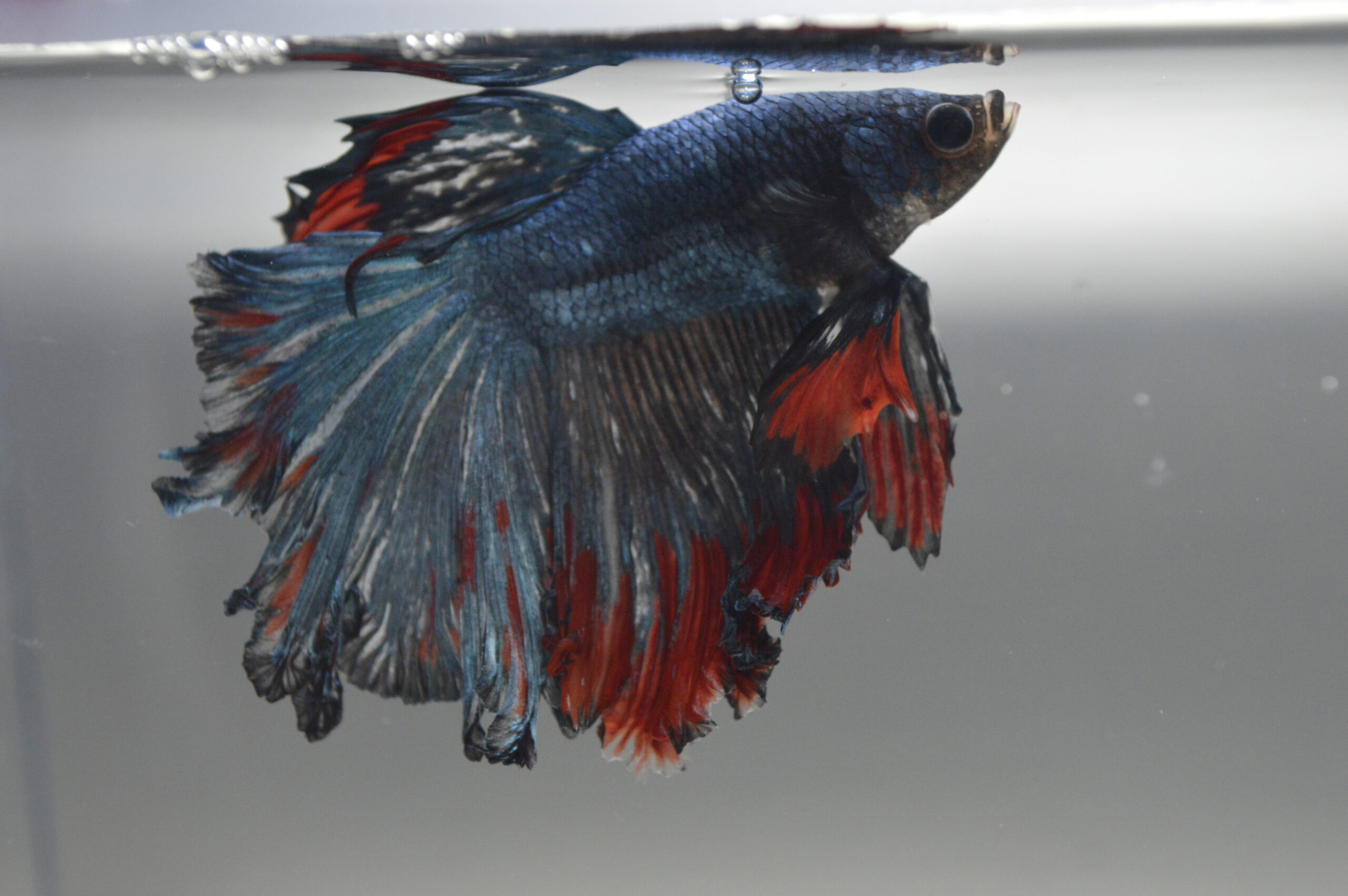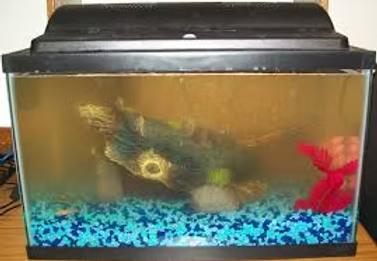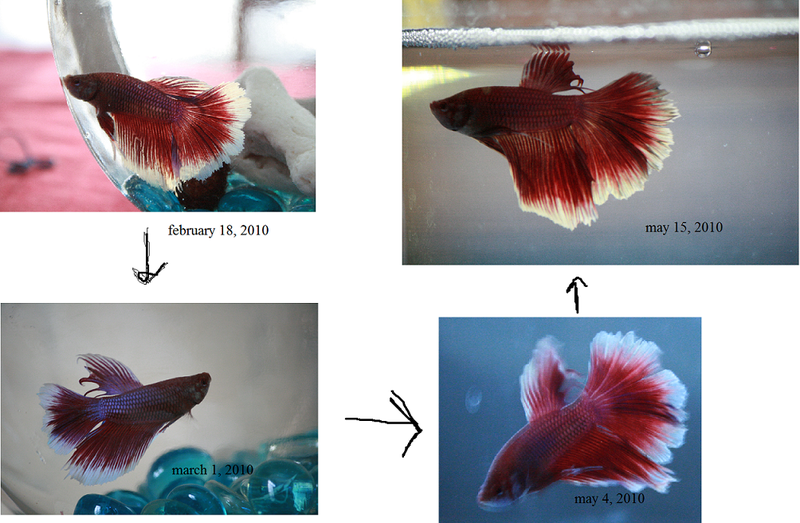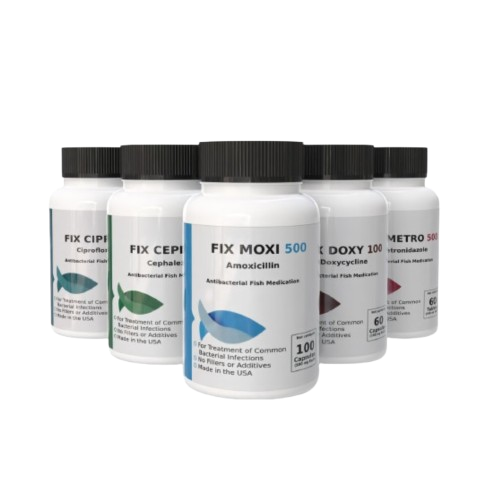Posted by Aquatic Veterinary Specialist on 10th Apr 2025
Betta Fish Fin Rot: Symptoms, Causes & Effective Treatment
Your Guide to Identifying, Treating, and Preventing Fin Rot in Betta Fish

Betta fish are known for their vibrant colors and beautiful, flowing fins. Unfortunately, those same fins can fall victim to a common ailment called fin rot. This condition causes a betta’s fins to gradually fray, discolor, and disintegrate due to bacterial or fungal infection. In this article, we’ll explain exactly what betta fin rot is, how to recognize the symptoms (both visual and behavioral), the typical causes (like poor water quality and stress), the stages of fin rot progression, and effective betta fin rot treatment options. We’ll also highlight some fish antibiotics available to treat severe cases and share prevention tips to keep your Siamese fighting fish healthy.
What Is Betta Fish Fin Rot? (Symptoms and Signs)
Fin rot is essentially the rotting or decaying of a fish’s fins. In bettas (Siamese fighting fish), it usually starts at the edge of the fins and works its way inward, causing the fins to appear ragged and shortened over time. Fin rot is often a symptom of an underlying issue (most commonly a bacterial infection, though fungal infections can also cause it). Bettas are especially prone to fin rot if kept in suboptimal conditions, as their long fins are delicate and easily damaged.

A male betta fish displaying frayed, deteriorating tail fins due to fin rot (circled). Such ragged, decaying fin edges are a hallmark symptom of fin rot. Fin rot damage typically begins at the fin tips and, if untreated, can progress towards the base of the fin. Once it reaches the fin’s base, the tissue may not grow back and the infection can even begin attacking the fish’s body (advanced fin and body rot). It’s crucial to catch this disease early. Common symptoms of betta fish fin rot include:
-
Frayed or torn fin edges: The fins (tail and/or other fins) look shredded, uneven, or as if pieces are missing. The damage often starts at the tips and moves inward.
-
Discolored fin edges: You may notice the edges of the fins turning brown, black, or white. Black or brownish edges can indicate dead tissue from a bacterial infection, while white fuzzy edging often suggests a fungal growth.
-
White cottony growth: In some cases, a white, fuzzy or cotton-like growth appears on the affected fin areas. This is usually fungus, which can accompany fin rot and make the fins look as if they have white mildew.
-
Clamped fins: A betta suffering from fin rot might keep its fins clamped or close to its body. Instead of fanning out boldly, the fins stay tight, which is a general sign of illness or stress.
-
Lethargy: Infected bettas often become less active. Your fish may spend more time resting at the bottom of the tank or hiding, and might not swim around as energetically as before.
-
Loss of appetite: As the condition worsens, the betta may eat less or show less interest in food. Lack of appetite, combined with lethargy, is a warning sign that the fish’s health is declining.
Visually, fin rot and tail rot look like the fish’s fins are rotting away. Tail rot is simply fin rot that is primarily affecting the tail (caudal) fin – since bettas have large tails, it’s often very noticeable there. Behaviorally, a betta with fin rot might seem “off” – less responsive, not flaring its fins, and generally looking unwell. If you observe ragged fins along with these behavioral changes, your betta likely has fin rot.
Common Causes of Fin Rot and Tail Rot in Bettas

Understanding what causes fin rot is important for both treatment and prevention. In most cases, fin rot in betta fish is triggered by environmental stress or injury which allows bacteria or fungus to take hold. Here are the most common causes:
-
Poor water quality: This is the number one culprit. Dirty water with high levels of waste (ammonia, nitrite, nitrate) stresses the fish and fosters bacteria. Fin rot is common in bettas kept in unclean conditions. Small containers or infrequent water changes can quickly lead to water quality issues that cause fin rot.
-
Stress: Any form of stress weakens a betta’s immune system (immune suppression). Causes of stress include a tank that’s too small, lack of hiding spots, sudden temperature changes, or aggressive tankmates. A stressed (and thus immuno-suppressed) betta is much more susceptible to fin rot infections.
-
Injury to the fins: Torn or nipped fins can become an entry point for bacteria. If your betta has tankmates that nip fins, or if it tears its fins on sharp decorations, those injuries can get infected and develop into fin rot. (Even bettas themselves sometimes bite their own tails when stressed or bored, leading to tail damage that can rot.)
-
Poor diet: A diet lacking essential nutrients can weaken a fish’s immune response. Bettas fed exclusively low-quality food may not have the strength to fight off infection, making fin rot more likely.
-
Other illness or immune suppression: Fin rot can occur as a secondary infection when a fish is already sick with something else. Any disease or parasite that burdens your betta can open the door for fin rot bacteria to invade the damaged or stressed tissue.
-
Cold water temperature: Bettas are tropical fish that need warm water (around 76–82°F or 24–28°C). In water that’s too cold, their metabolism slows and immunity drops. Prolonged cold conditions can stress the fish and promote bacterial growth, contributing to fin rot.
In summary, fin rot in Siamese fighting fish (betta) usually results from a combination of stress and opportunistic bacteria/fungus. The bacteria commonly involved (such as Pseudomonas or Aeromonas) thrive in filthy water and attack weakened fish, causing that characteristic fin decay. Fungal spores can also exploit poor conditions, especially if dead tissue is present, leading to that white “tail rot” edge. By recognizing these causes, you can both treat the current problem and fix the underlying issues to prevent recurrence.
Stages of Betta Fin Rot: Mild, Moderate, and Severe

Fin rot can progress if not addressed. There are generally three stages of fin rot in betta fish, each with distinct physical changes:
-
Mild Fin Rot (Early Stage): This is the initial stage where damage is just beginning. You might see slight fraying or pinholes at the tips of the fins. Discoloration is minimal – perhaps a bit of whitish or darker edging – and the rot has not yet reached the fin base. The betta usually acts normal or only slightly less active. At this stage, the fin loss is relatively small and might even be hard to notice without close inspection.
-
Moderate Fin Rot (Middle Stage): In this stage, the fin deterioration is clearly visible. The fins look significantly torn or ragged, with chunks of fin missing or hanging. The rot is moving closer to the base of the fins; you might see redness or inflammation at the fin roots, indicating infection, or observe fuzzy white growth on the frayed edges (a sign of fungal involvement). The betta’s behavior often worsens now – it may have clamped fins, reduced activity, and some loss of appetite as the infection spreads.
-
Severe Fin Rot (Advanced Stage): This is the most advanced and dangerous stage. Most of the fin tissue is destroyed, and the rot may have reached the fin base or even begun to attack the body of the fish (sometimes called “body rot”). The betta’s tail or fins might be almost completely gone, leaving only short stubs. Open wounds or ulcers can appear where the fins were, and you might see bloody streaks or extreme redness at the fin bases. At this severe stage, the betta will be very lethargic, often lying at the bottom, and likely not eating. The fish’s immune system is overwhelmed, and without prompt, aggressive treatment, fin rot at this stage can be fatal.
Being able to identify whether fin rot is mild, moderate, or severe will guide how you treat it. Early-stage (mild) fin rot is much easier to cure, whereas severe fin rot requires intensive care and medication. The good news is that with proper treatment, bettas can recover even from bad fin rot (though fins may not fully regenerate if the damage reached the base). In the next section, we’ll outline betta fin rot treatment strategies appropriate for each stage of the disease.
Effective Treatment Strategies for Betta Fin Rot

When it comes to treating fin rot, quick action is key. The earlier you start betta fin rot treatment, the better the chances your fish’s fins will heal. Treatment always begins with fixing the fish’s environment, and then escalates to medications if necessary. Below are effective treatment steps for mild, moderate, and severe fin rot:
-
Treating Mild Fin Rot (Improve Water Quality & Basic Care): For early-stage fin rot, often the only treatment needed is to improve the aquarium conditions. Start by doing a sizable water change (25-50% or more) to dilute any waste and remove bad bacteria. Make sure the new water is treated with a conditioner (to remove chlorine/chloramines) and is the appropriate temperature. Clean the tank of any uneaten food or debris. Often, simply keeping the water pristine – zero ammonia and nitrite, low nitrates – allows the betta’s fins to recover on their own. You can also add a small dose of aquarium salt (e.g. 1 teaspoon per gallon) as a tonic; salt helps fight infection and can promote healing. Ensure the filter is working properly (but remove any activated carbon if you plan to use medication later, since carbon can absorb the meds). Check the heater to maintain a stable tropical temperature around 78°F (25-26°C). At this mild stage, no antibiotics are needed. Just reduce stress for the fish: if it’s in a community tank, consider moving it to a quarantine tank so that no tankmates nip at it. With clean, warm water and a calm environment, you should see the fin rot stop worsening. The fin edges might begin to look clearer (a sign of healing) within a week.
-
Treating Moderate Fin Rot (Enhanced Care & Natural Remedies): If the fin rot has progressed or isn’t improving with basic water changes, you’ll need to step up the treatment. Continue with frequent water changes – possibly small daily changes (10-20% each day) or larger every few days – to keep conditions ideal. Increase the concentration of aquarium salt slightly (up to 2 teaspoons per gallon, for a short period) to boost its antimicrobial effect, but be careful using salt long-term with scaleless tankmates or live plants (if the betta is alone, short-term salt use is fine). Many betta owners also introduce natural remedies at this stage: for example, adding Indian almond leaf (catappa leaf) to the water. Indian almond leaves release tannins that have mild antibacterial and antifungal properties, and they can help reduce stress for the betta (the water will turn brownish, simulating the betta’s natural habitat). Observe the fins closely – if you see continued deterioration, you may use an over-the-counter antibacterial treatment from a pet store. Products designed for fin rot (often labeled as treatments for fin rot or fin & body fungus) usually contain broad-spectrum antibiotics or antiseptics safe for fish. Follow the product instructions carefully. Note: When treating in the main tank, remove activated carbon from the filter (as it will strip the medication out of the water). During treatment, keep the tank dim and low-stress. With moderate fin rot, you should start to see the rot slow down or stop after a few days of treatment. If it still keeps getting worse, prepare to treat it as a severe case and use stronger medication.
-
Treating Severe Fin Rot (Hospital Tank & Antibiotics): Severe fin rot in bettas calls for aggressive treatment with fish antibiotics. First, it’s best to move your betta to a hospital tank or quarantine container (if it isn’t already in one). A small, clean tank (even a simple 2-5 gallon container with a heater and aeration) is ideal for medicating your fish – this keeps the main tank safe and lets you do frequent water changes more easily. In the hospital tank, perform daily water changes if possible (e.g. 20-30% each day) to keep water ultra-clean, and re-dose medication as instructed after changes. Choose a proper antibiotic medication targeted at fin rot (which is usually bacterial). There are a variety of fish antibiotics available without a prescription that are effective against fin rot’s common bacteria. In the next section, we’ll go over some of these antibiotic options in detail. Always follow the dosage instructions on the antibiotic package, and complete the full course of treatment (typically 5-10 days) even if the fish’s fins start to look better sooner. While on antibiotics, feed the betta high-quality food to help it maintain strength (if it is still eating) and remove any leftover food promptly to keep water clean. Monitor the betta closely – in severe cases, you may even need to use a combination of treatments (for example, an antibiotic and an antifungal if both infections are present). If open wounds are on the body, a slime-coat enhancer or stress coat product can help protect those areas while they heal. Severe fin rot treatment can be challenging, but many bettas do pull through with the right care. Over the course of a couple of weeks, you should see new fin tissue growth (new fin edges often appear clear or translucent). Remember, if the rot had reached the base of the fin, the lost portions might not fully regenerate, but as long as the infection is cured, the betta can still live a healthy life.
Fish Antibiotics for Treating Severe Betta Fin Rot
In advanced cases of fin rot, using the right antibiotic can make the difference between recovery and further deterioration. Below are some fish antibiotics commonly used to treat severe fin rot and other bacterial infections in betta fish. (These are all formulated for use in aquariums and do not require a prescription for purchase.) Each antibiotic has a slightly different spectrum of bacteria it targets:
-
Fish Amoxicillin – A broad-spectrum antibiotic that is effective against many of the bacterial strains causing fin rot. Fish Amoxicillin is often used as a first-line treatment for persistent fin rot because it targets common gram-positive and gram-negative bacteria in fish.
-
Fish Cephalexin – A cephalosporin antibiotic that works similarly to amoxicillin, attacking a wide range of bacteria. It’s useful for fin rot cases that might not respond to penicillin-class drugs, and helps clear infections in fin tissue.
-
Fish Penicillin – An antibiotic effective mainly against gram-positive bacteria. In fish, it can help treat fin rot if the responsible bacteria are of the gram-positive type (or if the infection is secondary to a gram-positive bacterial issue). It’s sometimes used in combination with other meds for a broader effect.
-
Fish Ciprofloxacin – A potent fluoroquinolone antibiotic that is particularly good at targeting gram-negative bacteria (common culprits in fin rot). Ciprofloxacin is strong and often used for tough cases of fin rot or ulcer infections that don’t respond to other treatments.
-
Fish Metronidazole – An antimicrobial medication effective against certain parasites and anaerobic bacteria. While fin rot is usually due to aerobic bacteria, Fish Metronidazole can be useful if the fin rot is accompanied by secondary infections like internal bacterial infections or protozoan parasites. It’s often used in combination with other antibiotics for a comprehensive treatment.
-
Fish Clindamycin – An antibiotic that targets gram-positive bacteria and some anaerobes. Clindamycin can help treat stubborn fin rot cases, especially if lab tests (in professional settings) identify a gram-positive bacterium as the cause. It’s another tool in the arsenal when common antibiotics don’t fully knock out the infection.
-
Fish Azithromycin – A broad-spectrum macrolide antibiotic. Fish Azithromycin is used for treating various bacterial infections in fish, including fin and tail rot. It’s known for its anti-inflammatory properties as well, which can help reduce redness and swelling in infected fins.
-
Fish Doxycycline – A tetracycline-class antibiotic that’s effective against a wide range of bacteria. Fish Doxycycline is often chosen for fin rot and other aquarium infections because it can tackle both gram-positive and gram-negative bacteria. It’s a good option when you’re not exactly sure which bacteria is causing the fin rot.
-
Fish Sulfamethoxazole – A sulfa-based antibiotic (often combined with trimethoprim as TMP-SMX in human medicine) that inhibits bacterial growth. In fish, sulfamethoxazole is used to treat bacterial infections like fin rot by stopping the multiplication of bacteria, allowing the fish’s immune system to catch up. It’s broad-spectrum and can be very effective in aquarium use.
-
Fish Fluconazole – Note: Fluconazole is actually an antifungal (not an antibiotic), but it’s worth mentioning because fin rot can sometimes involve fungal infections. Fish Fluconazole is used to treat fungal issues on fish, such as true fungus on fins or mouth fungus. If your betta’s fin rot has a fuzzy fungal component, a medication like fluconazole can help eliminate the fungus while other antibiotics handle the bacteria.
All of these treatments are available through TheFishAntibiotics.com, making it convenient to find the right medication for your betta. Before using any antibiotic, remove any carbon from your filter (to prevent it from soaking up the medicine) and follow the dosage instructions carefully. It’s also wise to continue aeration in the hospital tank, as some antibiotics can reduce oxygen levels in the water. With proper use of these antibiotics, even severe cases of betta fin rot can be cured over time. Always monitor your fish during treatment – if you see improvement (fins stopping receding, behavior improving), continue the full course of meds. If there’s no improvement or the betta gets worse, you may need to try a different antibiotic or consult a vet experienced with fish.
Prevention Tips to Avoid Fin Rot in Betta Fish
Nobody wants their betta to experience fin rot again. The good news is that fin rot is largely preventable with good husbandry. Here are some prevention tips to keep your betta’s fins healthy and avoid future cases of fin rot:
-
Maintain excellent water quality: This is the single most important factor. Use a proper filter and perform regular water changes (for example, 25% weekly, or more often for smaller tanks). Test the water periodically for ammonia, nitrite, and nitrate. All should read 0 ppm except nitrates, which should be kept low (under ~20 ppm). Clean water greatly reduces the chance of fin rot.
-
Use an adequate tank size: Avoid keeping bettas in tiny bowls or cups. A tank of at least 5 gallons is recommended so that waste dilutes more and the environment stays stable. Smaller volumes pollute quickly, stressing the fish. A proper tank also allows you to heat and filter the water effectively.
-
Keep water conditions stable and appropriate: Bettas are tropical, so keep the water temperature in the 76-82°F range and steady (use a heater with a thermostat). Sudden drops or swings in temperature can stress the fish. Maintain a gentle water flow (bettas don’t like strong currents) and a pH around neutral (6.5–7.5, although bettas are adaptable if changes are gradual). Stability is key – drastic changes in pH or hardness can stress the fish’s immune system.
-
Avoid fin-nipping tankmates: If your betta is in a community tank, choose peaceful tankmates that won’t bite at its fins. Avoid known fin-nippers like some barbs or tetras. Aggression from other fish (or even from another betta in the case of sororities) can lead to torn fins and stress, both of which invite fin rot. When in doubt, house your betta singly or with very mellow companions like snails or gentle shrimp.
-
Provide a stress-free environment: Decorate the tank with plants (real or silk) and hides so your betta has places to explore and rest. This reduces boredom and stress. Ensure any decorations don’t have sharp edges – run a pantyhose or cloth over them; if it snags, it’s too sharp for delicate betta fins. Smooth decor means less chance of rips that could get infected. Also limit excessive bright lights or loud noises near the tank. A happy, low-stress fish is a healthy fish.
-
Feed a balanced, high-quality diet: Give your betta nutritious food to boost its immune system. High-protein betta pellets as a staple, supplemented with the occasional treat like frozen or freeze-dried bloodworms or brine shrimp, will keep your fish strong. Avoid overfeeding, as leftover food fouls the water. A strong immune system helps your betta fight off opportunistic infections that cause fin rot.
-
Quarantine new additions: If you add new fish or even live plants to an established tank, consider quarantining them first. New fish can carry bacteria or fungus that might cause fin rot or other diseases. A separate quarantine tank for a few weeks can ensure they are healthy before they join your betta’s home. Likewise, sterilize any new decor or equipment before use (rinse thoroughly) to avoid introducing pathogens.
-
Observe your betta regularly: Often, you can catch fin rot in its very early stages by simply paying attention. Take a close look at your betta’s fins every day during feeding time. If you notice any slight fraying or discoloration, act immediately with a water change and closer monitoring. Early intervention can prevent a mild case from turning into something more severe.
By following these prevention measures, you can greatly reduce the risk of fin rot taking hold. Bettas kept in clean, well-maintained tanks with low stress are far less likely to develop infections. Remember that betta fish fin rot treatment is effective, but it’s even better if you never need it in the first place. A healthy environment is the best medicine!
Final Thoughts
Fin rot is a common but manageable health issue in betta fish. By understanding the symptoms, causes, and treatment options, you can confidently care for your betta if this problem arises. Always start with the basics: clean water and reduced stress. In many cases, that’s enough to heal mild fin rot. For more advanced cases, don’t hesitate to use the available fish antibiotics to save your betta’s fins (and life). All the medications discussed are readily available and easy to use, especially through specialized aquarium suppliers like TheFishAntibiotics. With prompt care and a good prevention plan, your betta (aka Siamese fighting fish) can recover from fin rot and go back to displaying its beautiful fins in full glory. Happy fish keeping!

